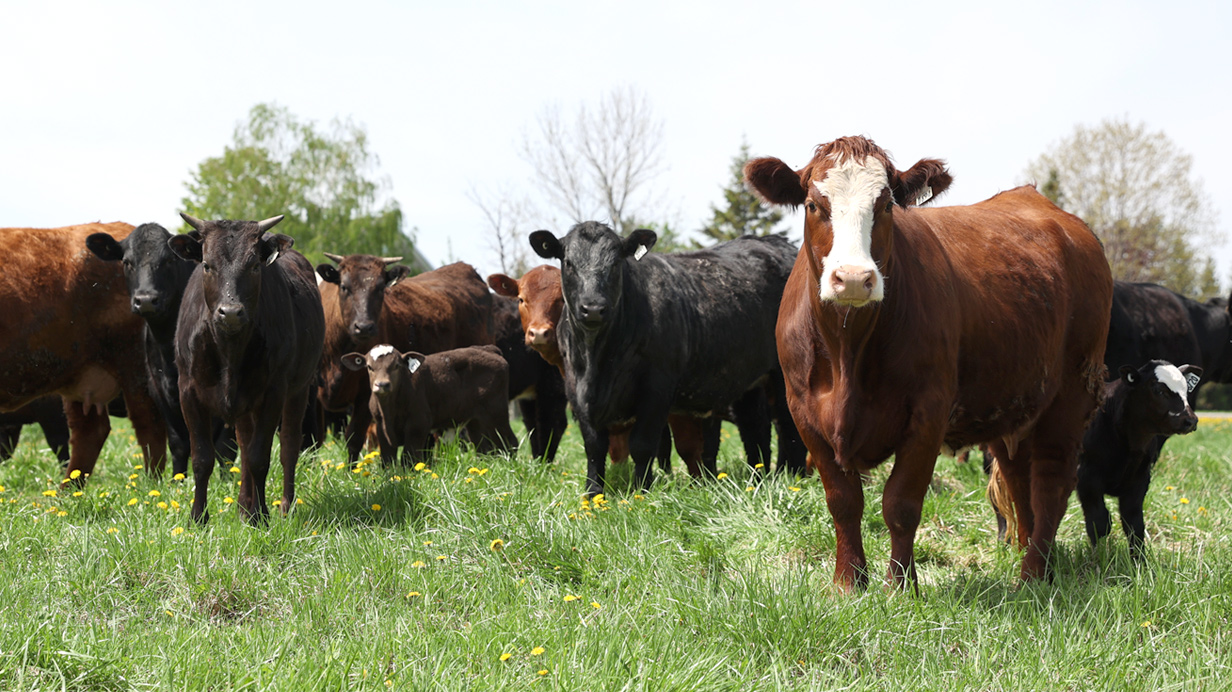Two good reasons to adopt intensive grazing
Intensive grazing is good for your wallet and good for the environment, two good reasons to adopt it and equip yourself to do it effectively.
Managing your pastures to get the most out of them is an art. It’s not enough to move your livestock from one field to another from time to time without any further agronomic consideration. There are several methods of pasture management, but for optimum results, intensive grazing has proved its worth.
What is intensive grazing?
Intensive grazing is a pasture management method characterized by rapid rotation of livestock on smaller plots. It is particularly suitable for cow-calf farmers but can be applied to any business using pasture.
What are the benefits of intensive grazing?
According to agronomist Elizabeth Lepage, Bovine Production Agri-advisor at Sollio Agriculture, there are many benefits to this method. “Intensive grazing can significantly increase forage yields and double the length of the grazing season, while improving the quality of the plants that the animals eat.”
Intensive grazing has a direct impact on farmers’ wallets, generating significant savings in feed costs (see table). For example, the cost of producing one tonne of mechanically harvested dry matter forage (round bale silage) is twice that of the same quantity when harvested directly by the animals under intensive grazing.
To reap the benefits of this method, you must leave sufficient vegetative cover and move your animals to another plot much more frequently than you would with extensive or rotational grazing.
The vegetative cover protects the soil from major temperature swings and helps it maintain good moisture levels. This encourages greater root density and improved biological activity. As a bonus, intensively managed land sequesters more carbon and provides better control of nitrogen loss through leaching and volatilization.
When should livestock be moved from one plot to another?
“Ideally, you want to remove your livestock from the plots when the grass is still 15 centimetres (6 inches) high,” says Lepage. “You need to adjust the frequency of plot rotation according to the growth rate of your plants. The faster they grow, the faster you should move the animals. The important thing is to make sure that your animals can’t reach the new growth and to give the plants enough time to rest to maximize recovery.”
Reducing the size of the plots results in more even grazing and distribution of organic fertilizer (manure and urine) over the entire plot area.
Properly managed pastures can be maintained for more than a decade without major tillage or mechanical reseeding. This is known as regenerative agriculture.
Is financial and technical support available?
Lepage is part of the first cohort of mentors to be trained in Québec as part of the first phase of a Canada-wide project on intensive pasture management (in French). The project is funded by the On-Farm Climate Action Fund, which helps farmers adopt beneficial and sustainable management practices to store carbon and reduce greenhouse gas emissions.
“In the second phase of the project, farmers were allotted money to buy hardware and cover the costs associated with setting up an intensive grazing system,” says Lepage. “Another part of the allocated funds is being used to pay for a grazing plan designed by an agronomist previously trained as part of the project.”
At the time of writing, the renewal of government funding for the purchase of equipment had not yet been announced. However, funding for agronomic advice and monitoring remains available from the allocated budget.
In addition to covering the development of grazing plans, the budget will also be used to fund activities related to intensive grazing, including training courses, field demonstrations and graziers’ clubs.
What do I need to implement an intensive grazing system?
Access to water is one of the limiting factors in implementing an effective and sustainable grazing system. If there aren’t enough watering points, the animals will often return to the same place to drink, trampling plants and affecting their recovery. As a result, existing water pipes often need to be extended and branched to accommodate additional drinking troughs. The number and capacity of drinking troughs needed will depend on the size of your herd and the layout of your plots.
To set up a drinking system with sufficient water pressure and flow, you will need a powerful pump and main water pipes with a minimum diameter of 2.5 centimetres (1 inch).
If your water is not supplied by the municipality, you’ll need to consider purchasing a solar panel or wind-power system with a capacity that matches the energy requirements of your chosen pump, as the project only subsidizes systems that use a renewable energy source.
Quick-Connect valves make it easier to connect and disconnect pipes and troughs when changing plots. “You also need to choose high-quality floats to control the opening of the valves and maintain a sufficient level of water in the troughs,” says Lepage.
For electric fences, we recommend using 12-gauge wire to achieve and maintain sufficient current. You need to provide enough earthing points for the energizer you choose. “Planning for too few earthing points is a common mistake that causes energy losses in the fence network,” says Lepage. “You need to plan one earthing point for every two joules of energy.”
Lepage also stresses the importance of using high-quality insulators to attach the wire to the fence posts. “If the plastic covering the insulator deteriorates from exposure to UV rays, the electric wire will come into contact with the insulator nail, causing a short circuit.”
Your local BMR/Agrizone dealer has a wide range of equipment to make life easier for farmers who practise intensive grazing, including stock tanks, fence energizers and wires and merchant wires. The Agrizone team, in conjunction with Sollio Agriculture, will be happy to advise you on the products best suited to your needs.
Source: The original version of this article was published in French in Coopérateur magazine.
Photo credit: Étienne Gosselin



